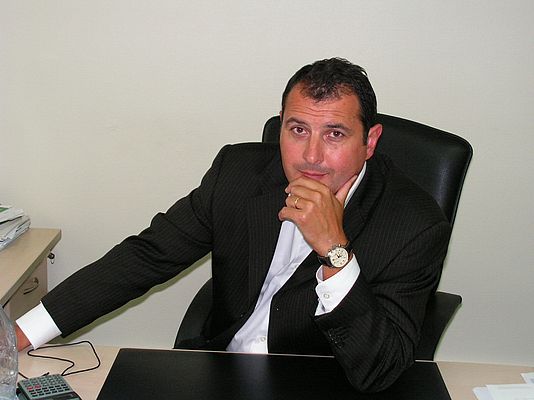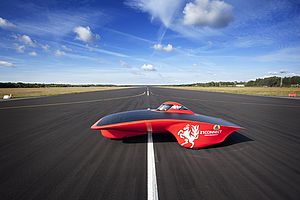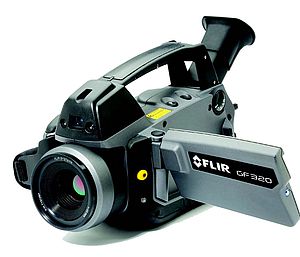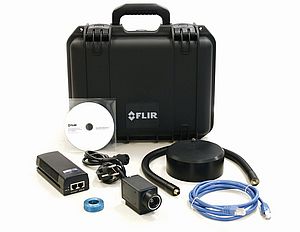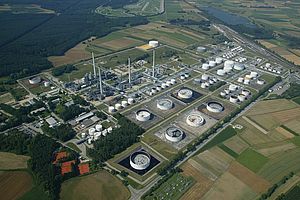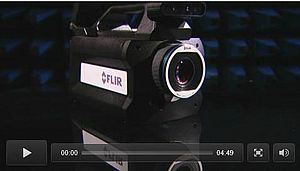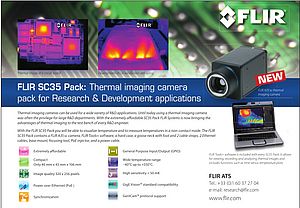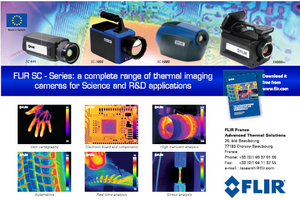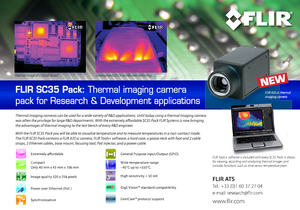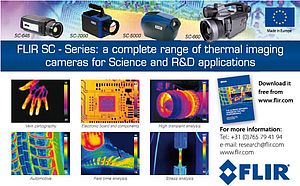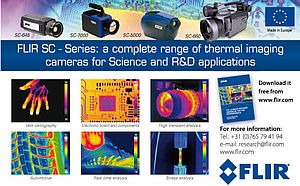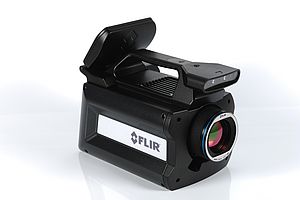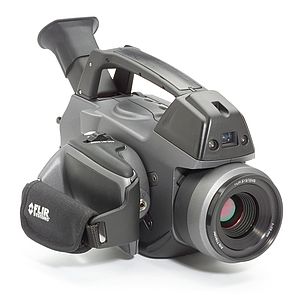IEN: Mr Premartin, with Flir ATS, your company has established its own business unit for thermal cameras used in Research and Development. What differentiate those thermal cameras from, let’s say, products used for industrial applications?
Premartin: The thermal imaging cameras from our division are based upon a different technical approach. When we talk about Advanced Thermal Solutions, we always try to use the best available technology, in terms of IR detector quality, optical design, drift compensation, temperature measurement accuracy, image triggering. Drawing a parallel to the motor industry our SC Line approach is similar to car manufacturers who also offer high performance versions on existing models such M series for BMW or S Line for Audi.
IEN: Does this show in the price of those cameras as well?
Premartin: Of course our SC thermal imaging cameras are a little more expansive compared to other existing standard IR cameras, but they offer advanced and unique features. By the way, our SC line starts just below 10K€, with the FLIR SC305. Interestingingly this is one-third of the price of our entrance level R&D product 3 years ago. Our philosophy is to be able to offer a top performance, optimized R&D Science product for almost any kind of budget. For thermographic measurement, as with any other type of imaging camera , to get the best performance, precision and capabilities you have to pay a premium.
IEN: Who are your main customers?
Premartin: Today, we can split the R&D-Science market into 2 different submarkets, Industrial R&D and Institutional R&D – which we at FLIR call Scientific R&D. For Industrial R&D, the main applications are Automotive, Electronic and Heat transfer measurements on any kind of product, material or domestic appliances. Today almost all quality commercial products, components or systems have been thermomonitored during their development process.
For Scientific R&D applications our customers work in areas including Universities, NDT (Non Destructive Testing), Lock-in thermography, Stress analysis, multispectral analysis, military/range and medical research.
IEN: How many cameras are presently in your product portfolio?
Premartin: Instead of numbers of cameras, we classify our product portfolio by the 3 different type of detector technology used by the cameras - uncooled Long Wave IR (LWIR, 8 to 12µm); cooled Mid Wave IR (MWIR) and LWIR technology (3 to 5µm and 8-12µm) and Short Wave IR (SWIR) technology (0,9µm to 1,7µm). FLIR uncooled IR technology is most commonly used for industrial applications. These industrial thermal imaging cameras e.g. FLIR SC655 are typically easy to use, offer good performances in terms of NETD (Noise Equivalent Thermal Difference) 30mK at 300K and are quite rapid in terms of image acquisition 200Hz (images per second). For applications that require ultimate performance we recommend our cooled cameras which offer leading edge sensitivity, speed, advanced capabilities and precision. An example of advanced capabilities on our cooled cameras is FLIR SnapShot mode technology developed for studing very rapid thermal phenomena. For such an application only a cooled FLIR thermal imaging camera will give you a superb IR image, with an extreme high thermal contrast without any blurring effects.
We recommend using cooled camera technology when you are faced with thermal applications which involve high speed motion, fast transient events, small thermal contrasts, very small objects, multi-spectral analysis and when the application requires a MWIR spectral response. Again to draw a parallel with the motorindustry, cooled cameras could be considered as IR Formula 1.
Our SWIR camera technology is mainly used for high temperature measurement (more signal from the object on this spectral band), laser alignment/analysis, visualization through paints and some other applications in the food industry. IEN: Are most of those cameras designed according to customer specifications? Premartin: For our uncooled cameras, the main adaptations are dedicated lenses, high temperature ranges or special calibration settings. For cooled cameras – FLIR typically adapt the camera with special application settings optimised for specific applications.
IEN: Is the ease of use regarding those cameras in the R&D sector less important than in other sectors, because all those users are thermal imaging experts?
Premartin: If we compare Scientific R&D to Industrial R&D customers, ease of use is indeed not the criteria number one. Science customers are looking for the best performance with a minimum of compromised. For Industrial R&D customers, ease of use is as important as the dedicated application performance and of course – price. As I mentioned before FLIR ATS have worked hard over the last few years to offer industrial R&D at really affordable prices.
IEN: Could you give us some examples of interesting applications?
Premartin: Recently we had some very interesting applications in the medical market. A FLIR ATS thermal imaging camera has been used during an heart operation to monitor temperature. The purpose was to cool down the heart before a valve implementation. FLIR thermal imaging cameras have been used by DLR/Airbus and Onera for development of next generation aircraft and research to improve automotive airbag technology.
IEN: Are there regional differences in product requirements for e.g. customers in Europe and those in the U.S. or Asia?
Premartin: The differences we face as a global business are more about our capability to export such advanced technologies. In the US - FLIR cameras are already equipped with HD detectors but soon, Europe will have some similar solutions available.
IEN: Is your R&D department completely separated from those colleagues who develop solutions for other markets, or do they cooperate in some way or another?
Premartin: Today with FLIR ATS (FLIR Advanced Thermal Solutions) we have more than 90 engineers and technicians dedicated to developing high tech solutions, not only for R&D and Science but also for Long distance surveillance and airborne thermal imaging applications. The main advantage of FLIR is that we are the only IR supplier with 100% control of our camera technology. At Santa Barbara, FLIR is manufacturing IR detectors. In Portland, Boston and Niceville (US), we develop and manufacture gimbals , stirling coolers, multi-sensors airborne and ground surveillance systems as well as high speed and HD cameras for the R&D and Science markets. In Europe, FLIR Danderyd (Sweden) is the worldwide manufacturing and development center for uncooled technology. FLIR Estonia is in charge of the low cost IR portable cameras (today FLIR is the first manufacturer capable to offer a radiometric portable camera, the FLIR I3, for less than 1.450€) and FLIR ATS Croissy-Beaubourg near Paris, is the development and manufacturing center of Advanced Thermal Solutions
IEN: With regard to technology transfer: Does it happen often that solutions developed for the R&D market find their way into those other markets, or vice versa?
Premartin: Absolutely, each FLIR market and each production center will get the benefit of the R&D and development investment of the entire FLIR organisation. I can confirm to you that FLIR every year invests 10% of its global turnover in Research and Development. Our company objectives are describes in 3 words - Trust Innovation Quality.
IEN: Could you please name some of the main current trends in thermal imaging for R&D?
Premartin: Industrial and Scientific researchers and developers using thermal imaging want higher resolution, greater sensitivity and more speed and all this at a lower cost. A real challenge isn’t it?
Facts & Figures:
Established: 1952 via AGA Infrared Imaging
Headquarters: PORTLAND Oregon (US)
Number of Employees: more than 2.500 employees worldwide
Turnover 2010: more than 1.62 billion USD
Main Products: Thermal imaging solutions for Research & Development in EMEA and APAC, FLIR SC Series (SC305/325, SC645/SC655, SC620/660 for uncooled cameras, SC5000 Series and SC7000 Series for Cooled solutions and SC2500 for SWIR/NIR applications)


